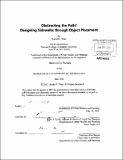| dc.contributor.advisor | Terry S. Szold. | en_US |
| dc.contributor.author | Blatt, Rachel E. (Rachel Elizabeth) | en_US |
| dc.contributor.other | Massachusetts Institute of Technology. Dept. of Urban Studies and Planning. | en_US |
| dc.coverage.spatial | n-us--- | en_US |
| dc.date.accessioned | 2012-10-10T15:47:34Z | |
| dc.date.available | 2012-10-10T15:47:34Z | |
| dc.date.copyright | 2012 | en_US |
| dc.date.issued | 2012 | en_US |
| dc.identifier.uri | http://hdl.handle.net/1721.1/73810 | |
| dc.description | Thesis (M.C.P.)--Massachusetts Institute of Technology, Dept. of Urban Studies and Planning, 2012. | en_US |
| dc.description | Cataloged from PDF version of thesis. | en_US |
| dc.description | Includes bibliographical references (p. 124-127). | en_US |
| dc.description.abstract | Vibrant multi-use sidewalks are designed in two phases. First there is the design of the physical infrastructure which determines sidewalk widths, materials, and the adjacent building fagades and roadway. Then there is the design problem of organizing objects on the sidewalk: where should the trees be planted, where do the lampposts, benches, trashcans, and signs get placed. Object placement is what identifies the sidewalk as a multi-use environment - making it both a space to move through and a place to gather in. Objects are furthermore an expression of property rights and the presence and absence of objects on a sidewalk are used to stake claims to the space for different purposes. The placement of objects is an ongoing process involving many public and private stakeholders, and thus policy is needed to manage object placements. This project utilizes a case study methodology and looks at the recorded sidewalk object policies in three of the most forward thinking cities in the US when it comes to utilizing sidewalks: New York, NY, Boston, MA, and Cambridge, MA. The municipal codes and written design guidelines are analyzed through the lenses of three claims to the sidewalk: the right to movement, the right to appropriation, and the right to commodification. With additional input from interviews with municipal staff members and consulting groups, this analysis reveals that municipalities are increasingly thinking about sidewalks as a space for more than just walking. Objects on the sidewalk have been assumed to be obstructions, disruptions to the official purpose of the sidewalk - walking. But the policies that are currently developing in New York, Boston, and Cambridge designate places for objects to be, allowing them to be evaluated from a neutral starting point. This shift in thinking about objects is still largely unconscious but necessary for planners, designers, and engineers to make, so that objects can be recognized for their design potential. Reframing objects as design elements in municipal laws and guidelines will open up new possibilities for creating lively sidewalks. | en_US |
| dc.description.statementofresponsibility | by Rachel E. Blatt. | en_US |
| dc.format.extent | 127 p. | en_US |
| dc.language.iso | eng | en_US |
| dc.publisher | Massachusetts Institute of Technology | en_US |
| dc.rights | M.I.T. theses are protected by
copyright. They may be viewed from this source for any purpose, but
reproduction or distribution in any format is prohibited without written
permission. See provided URL for inquiries about permission. | en_US |
| dc.rights.uri | http://dspace.mit.edu/handle/1721.1/7582 | en_US |
| dc.subject | Urban Studies and Planning. | en_US |
| dc.title | Obstructing the path? : designing sidewalks through object placement | en_US |
| dc.title.alternative | Designing sidewalks through object placement | en_US |
| dc.type | Thesis | en_US |
| dc.description.degree | M.C.P. | en_US |
| dc.contributor.department | Massachusetts Institute of Technology. Department of Urban Studies and Planning | |
| dc.identifier.oclc | 811247484 | en_US |
